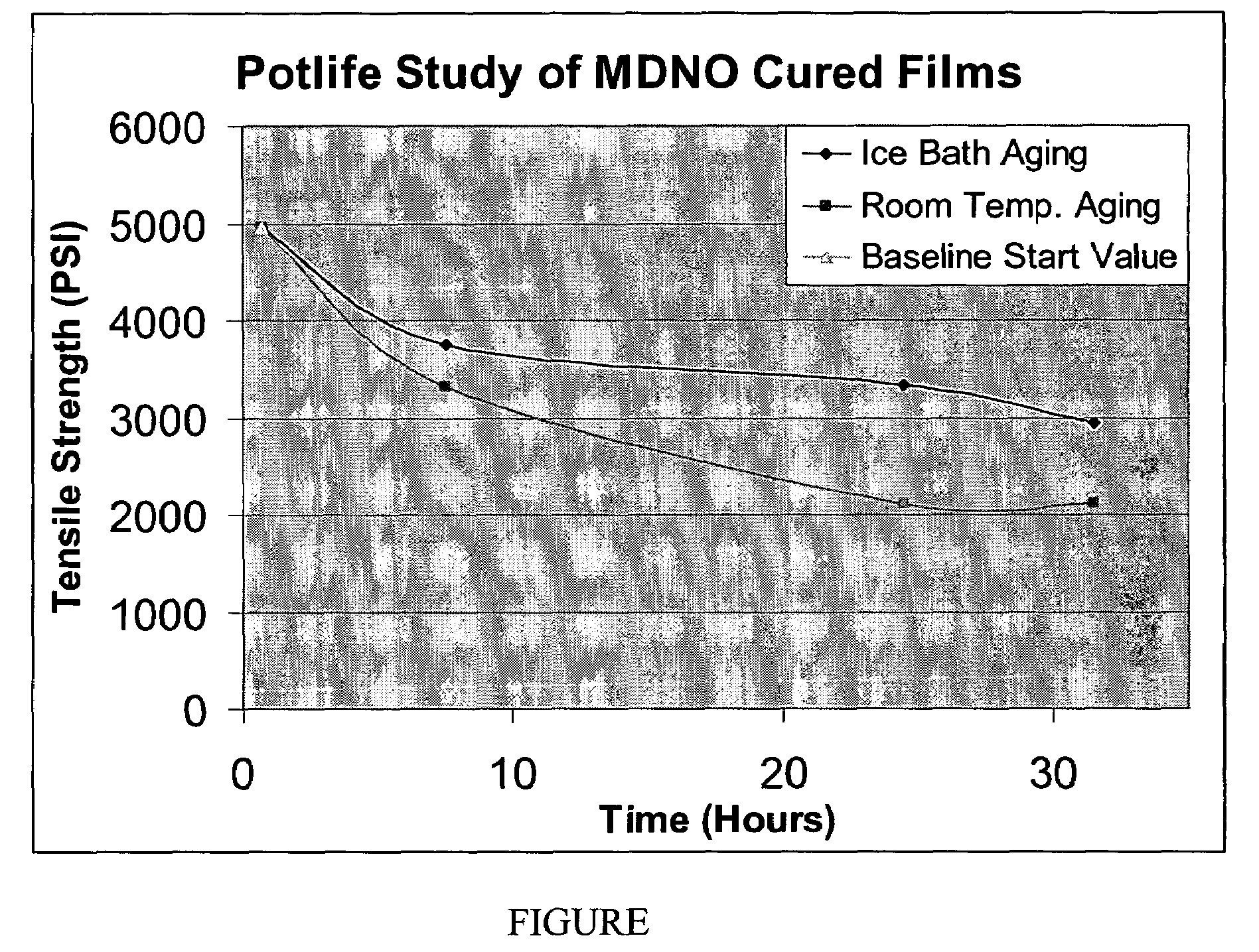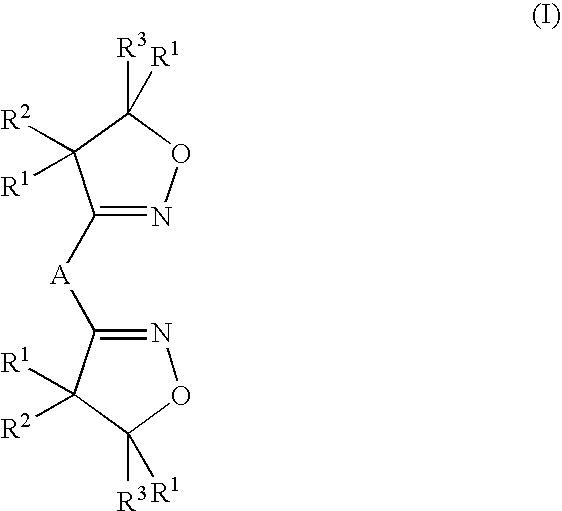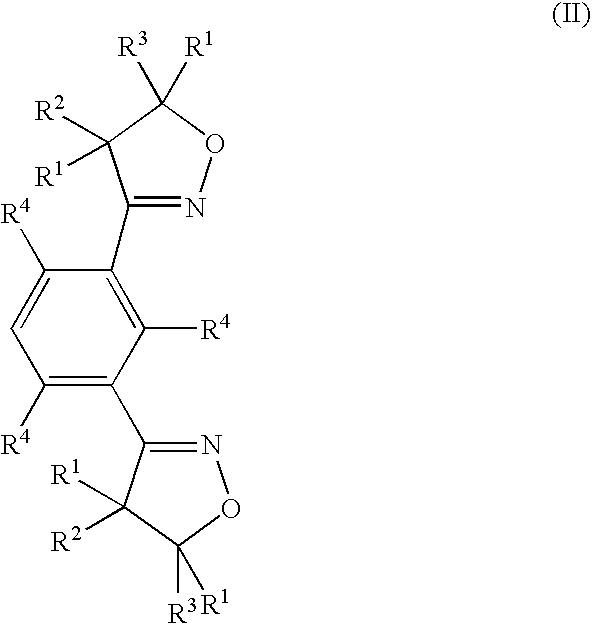Thin walled polynitrile oxide crosslinked rubber film products and methods of manufacture thereof
a technology of polynitrile oxide and crosslinked rubber, which is applied in the field of thin walled rubber film products, can solve the problems of user's hands becoming fatigued, degrading molecular weight, and difficult combination to achieve, and achieves the effects of improving tear and tensile strength, superior physical properties, and ultimate elongation
- Summary
- Abstract
- Description
- Claims
- Application Information
AI Technical Summary
Benefits of technology
Problems solved by technology
Method used
Image
Examples
example 1
Comparitive Preparation A
Comparison of Polyisoprene Latices Plus an SBR Reinforcing Agent Cured with MDNO (Example 1) and Dicumyl Peroxide (Comp. Prep. A) Crosslinking Agents
[0144]
TABLE 1MDNO and Peroxide-Cured Polyisoprene Filmswith SBR Reinforcing AgentExample 1Comp. Prep. AParts byParts by%Weight%WeightIngredientTSCa(Dry)TSC(Dry)Synthetic Polyisoprene Latex (SPIL)6010060100IR-307Styrene Butadiene Rubber Latex (SBR)52.4552.45MDNO Dispersion301.2——Dicumyl Peroxide Emulsion——371.2Darvan WAQ surfactant300.5300.5Cab-O-Sperse GP-50 Aqueous Silica202202DispersionAntioxidant Dispersion502502Deionized Water - as necessary to dilutecompound to 45% TSCa% TSC is Total Solids Content of Each Respective Ingredient
[0145]Determination of Tensile Properties
[0146]The dip-molded thin films prepared from the formulations of Example 1 and Comp. Prep. A were subjected to mechanical tests to determine their tensile properties. Values for 50%, 100%, 300%, and 500% tensile modulus were measured as well a...
example 2
Comparative Preparation B
Comparison of Polyisoprene Latices Cured with MDNO (Example 2) and Dicumyl Peroxide (Comp. Prep. B) Crosslinking Agents
[0149]
TABLE 3MDNO and Peroxide-Cured Polyisoprene Films (with SBR omitted)Example 2Comp. Prep. BParts byParts by%Weight%WeightIngredientTSC(Dry)TSC(Dry)Synthetic Polyisoprene Latex (SPIL)6010060100IR-307MDNO Dispersion301.2——Dicumyl Peroxide Emulsion——371.2Darvan WAQ surfactant300.5300.5Cab-O-Sperse GP-50 Aqueous Silica202202DispersionAntioxidant Dispersion502502Deionized Water - as necessary to dilutecompound to 45% TSC
[0150]
TABLE 4Comparison of Tensile Properties of MDNO andPeroxide Cured Polyisoprene FilmsPropertyExample 3Comp. Prep. BTensile Modulus 50%5648100%8477300%152165500%238335Ultimate Tensile Strength49123337(psi)Increase in Tensile Strength47.2%—(Ex. 2 vs Comp. Prep. B)Ultimate Percent1105791Elongation (%)Tear Strength (kN / m)33.211.2Increase in Tear Strength 196%—(Ex. 2 vs Comp. Prep. B)
[0151]As will be apparent from the precedi...
example 3
Comparative Preparative C
Comparison of Polyisoprene Latices Plus an SBR Reinforcing Agent, Cured with MDNO / Sulfur (Example 3) and Dicumyl Peroxide / Sulfur (Comp. Prep. C) Crosslinking Agents
[0152]
TABLE 5MDNO and Peroxide-Cured Polyisoprene Films (with sulfur)Example 2Comp. Prep. BParts byParts by%Weight%WeightIngredientTSC(Dry)TSC(Dry)Synthetic Polyisoprene Latex (SPIL)6010060100IR-307Styrene Butadiene Rubber Latex (SBR)52.4552.45Sulfur Dispersion680.4680.4MDNO Dispersion301.2——Dicumyl Peroxide Emulsion——371.2Darvan WAQ surfactant300.5300.5Cab-O-Sperse GP-50 Aqueous Silica202202DispersionAntioxidant Dispersion502502Deionized Water - as necessary to dilutecompound to 45% TSC
[0153]
TABLE 6Comparison of Tensile Properties of MDNO andPeroxide Cured Polyisoprene Films (with sulfur)PropertyExample 3Comp. Prep. CTensile Modulus 50%6555100%9680300%176150500%291245Ultimate Tensile Strength46664361(phi)Increase in Tensile Strength7.0%—(Ex. 3 vs Comp. Prep. C)Ultimate Percent10811084Elongation (...
PUM
| Property | Measurement | Unit |
|---|---|---|
| tensile strength | aaaaa | aaaaa |
| ultimate elongation | aaaaa | aaaaa |
| ultimate elongation | aaaaa | aaaaa |
Abstract
Description
Claims
Application Information
 Login to View More
Login to View More - R&D
- Intellectual Property
- Life Sciences
- Materials
- Tech Scout
- Unparalleled Data Quality
- Higher Quality Content
- 60% Fewer Hallucinations
Browse by: Latest US Patents, China's latest patents, Technical Efficacy Thesaurus, Application Domain, Technology Topic, Popular Technical Reports.
© 2025 PatSnap. All rights reserved.Legal|Privacy policy|Modern Slavery Act Transparency Statement|Sitemap|About US| Contact US: help@patsnap.com



